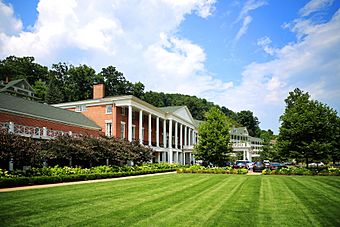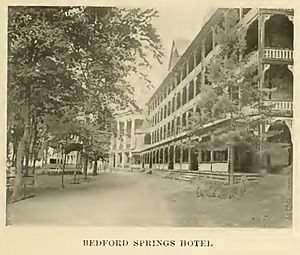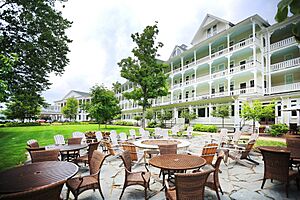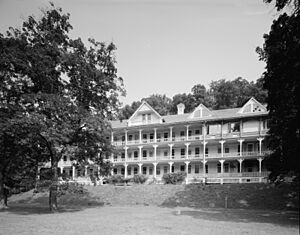Omni Bedford Springs Resort facts for kids
|
Bedford Springs Hotel Historic District
|
|

Omni Bedford Springs Resort - facade
|
|
| Location | Off of U.S. 220, Bedford, Pennsylvania |
|---|---|
| Area | 300 acres (120 ha) |
| Built | 1806 |
| Architect | Solomon Filler |
| Golf course designer | Spencer Oldham - 1895 A. W. Tillinghast - 1912 Donald Ross - 1923 |
| Architectural style | Colonia Revival, Greek Revival, Italianate |
| NRHP reference No. | 84001413 |
Quick facts for kids Significant dates |
|
| Added to NRHP | December 20, 1984 |
| Designated NHLD | July 17, 1991 |
The Omni Bedford Springs Resort is a famous hotel located near Bedford, Pennsylvania. It opened in 1806 and is one of the oldest and best-kept resort hotels from the 1800s. It is special because it was built around natural mineral springs.
This hotel was studied by the Historic American Buildings Survey in 2005. It is also a member of Historic Hotels of America. This is a special group that recognizes important historic hotels. The resort is part of the Omni Hotels & Resorts family. A large part of the resort, including the hotel, golf course, and springs, was named a National Historic Landmark in 1984. This means it is a very important historical place in the United States.
Contents
A Look Back: The Resort's History
How the Springs Were Discovered
In 1796, a man named Nicholas Shauffler found natural freshwater springs on land owned by Fredrick Naugel. These springs had many minerals in them. Local Native Americans had known about these springs for centuries. They believed the waters had special "healing powers." They would visit the springs to drink and bathe in the water.
In 1798, Doctor John Anderson bought the land with the springs. He built special bathing areas for his patients. This was the start of people coming to Bedford Springs for its waters. It laid the foundation for today's fancy Bedford Springs Resort. The resort is located right off the Pennsylvania Turnpike.
Growing Popularity and Famous Visitors
Dr. Anderson's treatments became very popular in the early 1800s. By 1809, there were three buildings at the site. These included The Stone House and Crockford. A traveler named Joshua Galpin visited in 1809. He wrote that the resort had a "large frame lodging house" and smaller ones for families. It also had baths and a billiard room.
In 1824, Bedford Springs was called the "Montpelier of America." This was in a newspaper article that praised its waters, rooms, activities, and food. The resort became even more popular as cities became crowded and polluted. People wanted to enjoy outdoor life. It also became easier to reach. Starting in 1872, trains from the B&O and Pennsylvania Railroad stopped in Bedford. This made it easy for people from Washington, D.C., Philadelphia, and New York City to visit.
Bedford Springs became a favorite spot for politicians. President James Buchanan used it as his "Summer White House" from 1857 to 1861. Other presidents like William Henry Harrison, James K. Polk, and Zachary Taylor also visited. Many senators and congressmen came with their families too. On August 12, 1858, the first message from the transatlantic cable was sent from England. President Buchanan received it at the hotel.
Golden Age and Changes Over Time
The late 1800s were a "golden age" for grand resorts in America. Bedford Springs was seen as the best. The grounds had colorful spring houses, bridges, and gates. A special "serpentine trail" led visitors from one spring to another.
In the early 1900s, people learned more about medicine. The idea of the springs having "healing powers" became less important. But the hotel still did well. In 1905, it had a big makeover. A large double-decked walkway was added. This connected the main dining room to a building at the Magnesia Springs. A new building with an indoor pool was also built. This pool was fed by spring water. It was one of the first of its kind in the United States.
In the 1930s, the hotel's doctor, Dr. William E. Fitch, created the "Bedford Cure." This was a health plan that required a three-week stay at the resort. The resort continued to do well through the 1930s and 1940s. During World War II, the U.S. Navy used the hotel. It was first a training school for radio operators. Later, it was a place where Japanese diplomats were held.
Decline and Rebirth
The 1950s brought many updates to the hotel. Modern air conditioning and fire safety systems were installed. In 1950, Bedford Springs also stayed open all year for the first time. The hotel kept operating for the next 30 years. In 1975, then-California Governor Ronald Reagan stayed there. He was the seventh president (current, former, or future) to visit Bedford Springs.
However, people's travel tastes changed over the years. The resort finally closed in 1986. Two years later, a big flood badly damaged some buildings. The site fell into disrepair. Even so, it was added to the National Register of Historic Places in 1984. This recognized its historical importance.
In 1998, a company called Bedford Resort Partners Limited bought the property for $8 million. They started a huge project to bring Bedford Springs back to its former glory.
The Special Mineral Springs
The Bedford Springs were thought to have different health benefits. This was because each spring had its own mix of minerals. The "Bedford Cure" meant drinking water from different springs every day. The type of water depended on what a person needed.
- Magnesium Spring: Used for stomach problems.
- Iron Spring: Prescribed for low iron and strong bones.
- Black Spring: Mainly used to water the golf course.
- Sweet Spring: Had the best-tasting water.
An eighth spring, called the Eternal Spring, was found in 2006. This happened during the resort's expansion and renovation.
The Resort Today
The hotel welcomed guests again on July 12, 2007. The old hotel buildings were fully restored and updated. New parts were also added. In January 2009, Omni Hotels bought the resort. Omni Hotels is a luxury brand with hotels in the United States, Canada, and Mexico.
The restored resort has 216 rooms and 4 suites. It also has a golf course, a spa, and a conference center. The spa area has more rooms and a full-service spa. The hotel has a restaurant with 130 seats. There is also a restored colonial-style tavern in the Stone House. This tavern has original stone walls and beams from 1806.
The updated resort also has a new outdoor pool. The original indoor pool, fed by mineral springs, was also fully restored. The resort offers many outdoor activities. These include hiking, bicycling, off-road Segways, and UTVs. You can also go cross-country skiing, fly fishing, river rafting, or take carriage rides. Day trips to Bedford's historic sites and beautiful covered bridges are also available.
Golfing at Bedford Springs
The resort's golf course is one of the oldest in the United States. Spencer Oldham first designed it in 1895. In 1901, the head golf professional, Charles Thorn, improved the course. He rebuilt greens and tee boxes. He also put in an irrigation system using the natural springs for water.
In 1912, A.W. Tillinghast redesigned the course, making it 9 holes. Then, in 1923, Donald Ross redesigned it again, bringing it back to 18 holes. During the resort's big restoration, the golf course was brought back to Donald Ross's 1923 design.
As part of the resort's reopening, the Tillinghast/Ross course was greatly renovated. Over time, the course had suffered from dirt filling in the edges of the waterways. Also, "modern" landscaping in the 1950s tried to make the creek edges look "tidy." The renovation of the course, now called the Bedford Springs Old Course, restored the natural spring beds. They used native grasses and other natural materials from the area. Since the course is next to Shober's Run, you can see water features on almost every hole.
Relaxing at the Spa
The Springs Eternal Spa is a large spa and salon. It is about 30,000-square-foot (2,800 m2) in size. This spa is fed by the recently found eighth spring. It honors what has always made Bedford Springs a special place. The spa's main treatment is called The Bedford Baths. This involves moving between hot and cool pools. You also soak in steam infused with herbs from the mineral-rich springs.
See also
 In Spanish: Omni Bedford Springs Resort para niños
In Spanish: Omni Bedford Springs Resort para niños
- List of Historic Hotels of America
- List of National Historic Landmarks in Pennsylvania
- National Register of Historic Places listings in Bedford County, Pennsylvania






